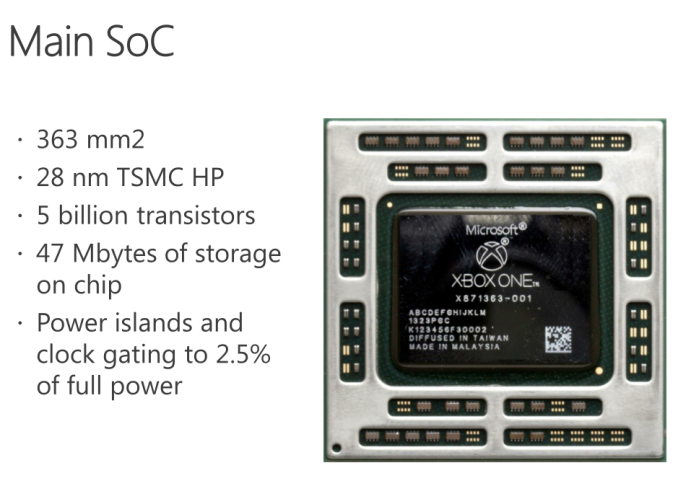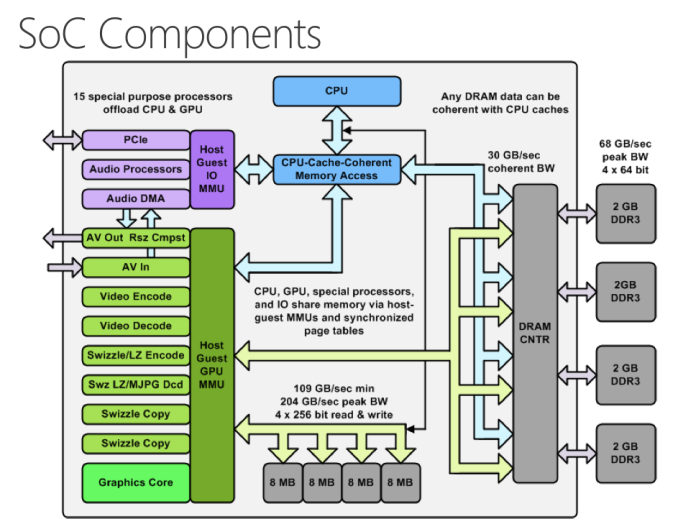The Xbox One - Mini Review & Comparison to Xbox 360/PS4
by Anand Lal Shimpi on November 20, 2013 8:00 AM ESTPerformance - An Update
The Chipworks PS4 teardown last week told us a lot about what’s happened between the Xbox One and PlayStation 4 in terms of hardware. It turns out that Microsoft’s silicon budget was actually a little more than Sony’s, at least for the main APU. The Xbox One APU is a 363mm^2 die, compared to 348mm^2 for the PS4’s APU. Both use a similar 8-core Jaguar CPU (2 x quad-core islands), but they feature different implementations of AMD’s Graphics Core Next GPUs. Microsoft elected to implement 12 compute units, two geometry engines and 16 ROPs, while Sony went for 18 CUs, two geometry engines and 32 ROPs. How did Sony manage to fit in more compute and ROP partitions into a smaller die area? By not including any eSRAM on-die.
While both APUs implement a 256-bit wide memory interface, Sony chose to use GDDR5 memory running at a 5.5GHz data rate. Microsoft stuck to more conventionally available DDR3 memory running at less than half the speed (2133MHz data rate). In order to make up for the bandwidth deficit, Microsoft included 32MB of eSRAM on its APU in order to alleviate some of the GPU bandwidth needs. The eSRAM is accessible in 8MB chunks, with a total of 204GB/s of bandwidth offered (102GB/s in each direction) to the memory. The eSRAM is designed for GPU access only, CPU access requires a copy to main memory.
Unlike Intel’s Crystalwell, the eSRAM isn’t a cache - instead it’s mapped to a specific address range in memory. And unlike the embedded DRAM in the Xbox 360, the eSRAM in the One can hold more than just a render target or Z-buffer. Virtually any type of GPU accessible surface/buffer type can now be stored in eSRAM (e.g. z-buffer, G-buffer, stencil buffers, shadow buffer, etc…). Developers could also choose to store things like important textures in this eSRAM as well, there’s nothing that states it needs to be one of these buffers just anything the developer finds important. It’s also possible for a single surface to be split between main memory and eSRAM.
Obviously sticking important buffers and other frequently used data here can definitely reduce demands on the memory interface, which should help Microsoft get by with only having ~68GB/s of system memory bandwidth. Microsoft has claimed publicly that actual bandwidth to the eSRAM is somewhere in the 140 - 150GB/s range, which is likely equal to the effective memory bandwidth (after overhead/efficiency losses) to the PS4’s GDDR5 memory interface. The difference being that you only get that bandwidth to your most frequently used data on the Xbox One. It’s still not clear to me what effective memory bandwidth looks like on the Xbox One, I suspect it’s still a bit lower than on the PS4, but after talking with Ryan Smith (AT’s Senior GPU Editor) I’m now wondering if memory bandwidth isn’t really the issue here.
| Microsoft Xbox One vs. Sony PlayStation 4 Spec comparison | ||||||||||||||
| Xbox 360 | Xbox One | PlayStation 4 | ||||||||||||
| CPU Cores/Threads | 3/6 | 8/8 | 8/8 | |||||||||||
| CPU Frequency | 3.2GHz | 1.75GHz | 1.6GHz | |||||||||||
| CPU µArch | IBM PowerPC | AMD Jaguar | AMD Jaguar | |||||||||||
| Shared L2 Cache | 1MB | 2 x 2MB | 2 x 2MB | |||||||||||
| GPU Cores | 768 | 1152 | ||||||||||||
| GCN Geometry Engines | 2 | 2 | ||||||||||||
| GCN ROPs | 16 | 32 | ||||||||||||
| GPU Frequency | 853MHz | 800MHz | ||||||||||||
| Peak Shader Throughput | 0.24 TFLOPS | 1.31 TFLOPS | 1.84 TFLOPS | |||||||||||
| Embedded Memory | 10MB eDRAM | 32MB eSRAM | - | |||||||||||
| Embedded Memory Bandwidth | 32GB/s | 102GB/s bi-directional (204GB/s total) | - | |||||||||||
| System Memory | 512MB 1400MHz GDDR3 | 8GB 2133MHz DDR3 | 8GB 5500MHz GDDR5 | |||||||||||
| System Memory Bus | 128-bits | 256-bits | 256-bits | |||||||||||
| System Memory Bandwidth | 22.4 GB/s | 68.3 GB/s | 176.0 GB/s | |||||||||||
| Manufacturing Process | 28nm | 28nm | ||||||||||||
In order to accommodate the eSRAM on die Microsoft not only had to move to a 12 CU GPU configuration, but it’s also only down to 16 ROPs (half of that of the PS4). The ROPs (render outputs/raster operations pipes) are responsible for final pixel output, and at the resolutions these consoles are targeting having 16 ROPs definitely puts the Xbox One as the odd man out in comparison to PC GPUs. Typically AMD’s GPU targeting 1080p come with 32 ROPs, which is where the PS4 is, but the Xbox One ships with half that. The difference in raw shader performance (12 CUs vs 18 CUs) can definitely creep up in games that run more complex lighting routines and other long shader programs on each pixel, but all of the more recent reports of resolution differences between Xbox One and PS4 games at launch are likely the result of being ROP bound on the One. This is probably why Microsoft claimed it saw a bigger increase in realized performance from increasing the GPU clock from 800MHz to 853MHz vs. adding two extra CUs. The ROPs operate at GPU clock, so an increase in GPU clock in a ROP bound scenario would increase performance more than adding more compute hardware.
 The PS4's APU - Courtesy Chipworks
The PS4's APU - Courtesy Chipworks
Microsoft’s admission that the Xbox One dev kits have 14 CUs does make me wonder what the Xbox One die looks like. Chipworks found that the PS4’s APU actually features 20 CUs, despite only exposing 18 to game developers. I suspect those last two are there for defect mitigation/to increase effective yields in the case of bad CUs, I wonder if the same isn’t true for the Xbox One.
At the end of the day Microsoft appears to have ended up with its GPU configuration not for silicon cost reasons, but for platform power/cost and component availability reasons. Sourcing DDR3 is much easier than sourcing high density GDDR5. Sony managed to obviously launch with a ton of GDDR5 just fine, but I can definitely understand why Microsoft would be hesitant to go down that route in the planning stages of Xbox One. To put some numbers in perspective, Sony has shipped 1 million PS4s thus far. That's 16 million GDDR5 chips, or 7.6 Petabytes of RAM. Had both Sony and Microsot tried to do this, I do wonder if GDDR5 supply would've become a problem. That's a ton of RAM in a very short period of time. The only other major consumer of GDDR5 are video cards, and the number of cards sold in the last couple of months that would ever use that RAM is a narrow list.
Microsoft will obviously have an easier time scaling its platform down over the years (eSRAM should shrink nicely at smaller geometry processes), but that’s not a concern to the end user unless Microsoft chooses to aggressively pass along cost savings.













286 Comments
View All Comments
Stuka87 - Wednesday, November 20, 2013 - link
Hmm, seems they are 360P when viewed on youtube, but HD is available if watching the embedded version. Strange.Hubb1e - Wednesday, November 20, 2013 - link
I was able to see the 4K versions actually which was pretty cool. First time I've actually seen a 4K video from youtube.Shadowmaster625 - Wednesday, November 20, 2013 - link
Microsoft is just beyond stupid. It's nothing to produce GDDR5. It costs basically the same amount of money to produce 50 million GDDR5 chips vs 50 million DDR3 chips. That is the whole point of making a gaming console in the first place. You get massive volume discounts on all your parts. Only a fool would buy an xbox, there is absolutely no reason to.. its not like microsoft is going to have that much exclusivity.tipoo - Wednesday, November 20, 2013 - link
A few dollars extra across say 80 million units is a lot. Do I wish they used GDDR5? Yes. But their decisions are based on their own cost analysis.Tyns - Wednesday, November 20, 2013 - link
The predicted price and availability of GDDR5 was highly questionable at the time MSFT needed to commit to the decision. Sony gambled and it happened to work out for them. A 6 month to 1 year delay or an extra $100-200 for the console would have been devastating if it had gone the other way, no?Sony's gamble paid off an now MSFT looks foolish, which is a shame for all of us.
Hubb1e - Wednesday, November 20, 2013 - link
I had also heard that Sony had decided to go with 4GB of GDDR5 but decided to double that when MS announced 8GB. Half the ram on the sony box would have hurt its ability to take advantage of its better hardware.TEAMSWITCHER - Wednesday, November 20, 2013 - link
I thought the image quality differences would be more subtle. But watching the COD:Ghosts video side-by-side you can see there is a more pronounced "shimmering" in the image on the Xbox One. Microsoft screwed up - I didn't spend $1500 on an HDTV to look at crappy images. Fore me the choice is clear - the PS4 wins this round. If enough people avoid the Xbox One, next year there won't be exclusive titles to miss out on.Kurge - Wednesday, November 20, 2013 - link
COD is badly coded, and what you don't see in the video is the frame rate choking of the PS4.What now?
Revdarian - Sunday, November 24, 2013 - link
Actually DF found out that CoD on the PS4 was running too fast, and that was the issue.Flunk - Wednesday, November 20, 2013 - link
Thanks for confirming my suspicions that it’s likely going to be a good 12 - 24 months before we'll need to buy one of these new systems. Call me old fashioned but I like for that "killer" app before I upgrade to new hardware.